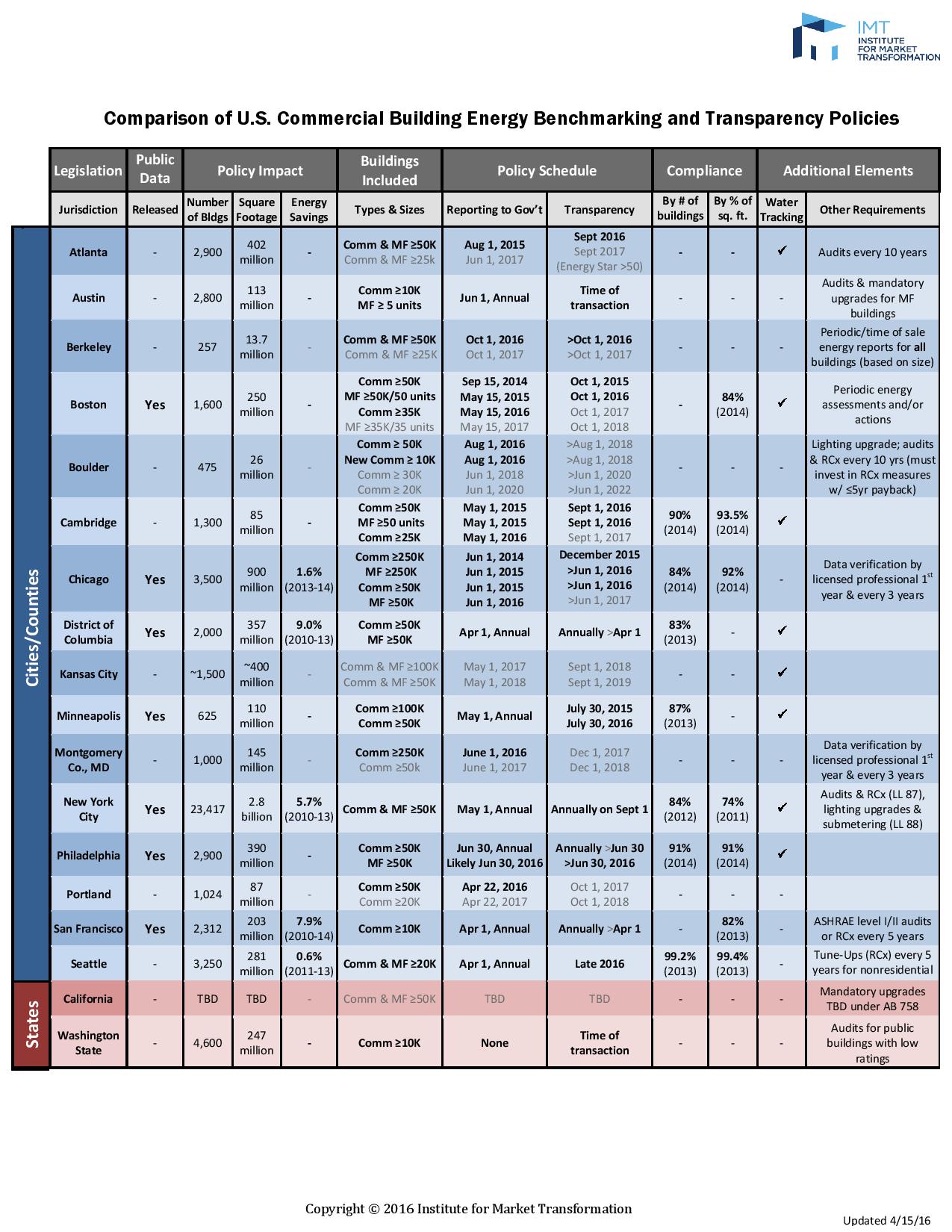
Expert Q&A: Driving Energy Efficiency Improvements with Better Data (Pt 2)
Urjanet Inc | May 9, 2016 | Energy & Sustainability
Reducing building energy consumption is a collaborative effort, requiring buy-in from stakeholders and policymakers from individual building occupants to the U.S. federal government. Here’s Part 2 of our interview with The Institute for Market Transformation’s (IMT) Sr. Program Associate Zachary Hart, who shared with us his unique insights on the data required for benchmarking building energy use using ENERGY STAR® Portfolio Manager®, the complexities of gathering and inputting that data, and how policy is shaping energy-saving efforts across the U.S.
Q: What is the main challenge building owners face when gathering data for benchmarking?
ZH: It can be hard for building owners to gather their data when utilities don’t provide it in an aggregated format for the whole building. It becomes even more onerous for a building owner to comply if there are many tenants in his or her building.
Imagine asking 300 tenants every month or year for their utility data. An automated data collection approach can really help when ongoing data from many different parties is needed.
Q: Have you seen any pushback from tenants regarding data privacy issues?
ZH: Yes, that’s certainly an issue. Tenants don’t always want to disclose their utility data, which they believe is their private information. That’s why data aggregation and anonymization is so important. There certainly are legitimate debates about the right amount of data to be collected and shared. Cities are working through this with their local stakeholders and coming up with agreements.
Q: Do you think there will ever be a standard for the way utilities format whole building energy data and provide it to their customers?
ZH: I’m not sure if this will ever happen across all utilities, but some efforts towards standardization are being made. The Building Energy Data Exchange Specification (BEDES) is an effort to formalize how energy data is named and organized. Additionally, the Department of Energy (DOE) launched the SEED Platform Collaborative, which is an effort to standardize how data is collected and transferred between systems.
Q: Do you think most laws will remain at the city level or will they shift towards the state level?
ZH: Right now, there are two states that have benchmarking laws: Washington and California. A number of other states have executive orders for their publicly-owned buildings, but only those two I mentioned have requirements for private buildings.
I think buildings will mostly stay regulated at the local level. We’ve seen mayors really take an interest in sustainability over the last decade or so. More and more are realizing that their building stock is a huge contributor to emissions. As they continue to develop more ambitious climate goals, they realize that they have to do something about energy consumption in buildings. That’s likely why we’re seeing more activity at the city level.
Q: What differences are you seeing in benchmarking and transparency ordinances from city to city?
ZH: The unique political cultures have a big influence on what types and sizes of buildings are covered. This type of policy is still in its early days, so cities are experimenting to see what works best. However, jurisdictions are starting to coalesce around some basic principles about building types and phasing them in at certain sizes. I think you’ll see a consensus start to form on the basics of how these policies are structured.

Q: What would you say are the top 3 barriers for companies or individuals with large portfolios to comply with their local ordinance?
ZH: I’d say getting accurate building characteristic data, access to utility data, and understanding utility data. As buildings get larger or as you deal with more and more buildings, it becomes harder to collect accurate information on occupancy, number of computers, gross square footage, and more.
As for access to utility data, some cities have done a good job of partnering with utilities, but many don’t. Also, utility data can be complex, so knowing what you need to enter into Portfolio Manager for each bill can get confusing. You can use the default settings, but Portfolio Manager then takes an average and adds something around 25%, so this can really hurt your score. It’s worth it to make sure you have good data access and that everything is being entered in accurately.
Q: When do you think it makes sense for building owners to leverage third party services to collect and input data into Portfolio Manager on their behalf?
ZH: If owners find that the data collection process is too complex or time consuming, they should consider using a third party service provider. It can be more cost-effective to partner with a company that specializes in data aggregation and has a solid process down. Owners should really consider the opportunity costs of taking on the entire process internally versus using a partner.
Q: Let’s say a building owner benchmarks his building and receives a low score. What might prevent him from investing in or upgrading his building?
ZH: There are a number reasons that building owners may have resistance to building efficiency upgrades. Some include capital constraints, time constraints, where they are in their capital planning process, and other things of that nature.
Even a lack of knowledge about energy services or where to go for help can prevent building owners from making those investments. This is something that cities are working on, trying to connect building owners with service providers and various financing options.
Q: Do building owners often see room for improvement once they’ve benchmarked their building’s data?
ZH: Even just directing owners’ attention to building energy use helps the owners identify ways they can save. They can almost always make at least small improvements that are low or even no cost. In general, we’re seeing a 1-2% savings year-over-year in the cities that have tracked this information.
Missed Part 1? Read it here: Driving Energy Efficiency Improvements with Better Data (Part 1)
Want to learn more about how to drive improvements in energy efficiency with better data? In a new eBook by Urjanet, with insights from the EPA, IMT, The Cadmus Group, and Southface, you’ll learn how to comply with building energy benchmarking and transparency laws while saving money and reducing energy consumption. Download the eBook today!
Related Resources:
- More Than a Bill: Why It’s Time for CFOs to Change How They Think About Utility Data
- 3 Ways to Improve Your ENERGY STAR Score
- Solutions Sheet: Utility Interval Data
If you like what you’re reading, why not subscribe?
About Urjanet Inc
Urjanet, the global leader in utility data aggregation, simplifies how organizations access and use utility data, enabling them to focus on their business. Our technology collects, processes, and delivers data from over 6,500 electric, natural gas, water, waste, telecom, and cable utilities worldwide.
You May Also Like
Support Business Continuity by Embracing ESG
Honor Donnie | March 18, 2022 | Energy & Sustainability
